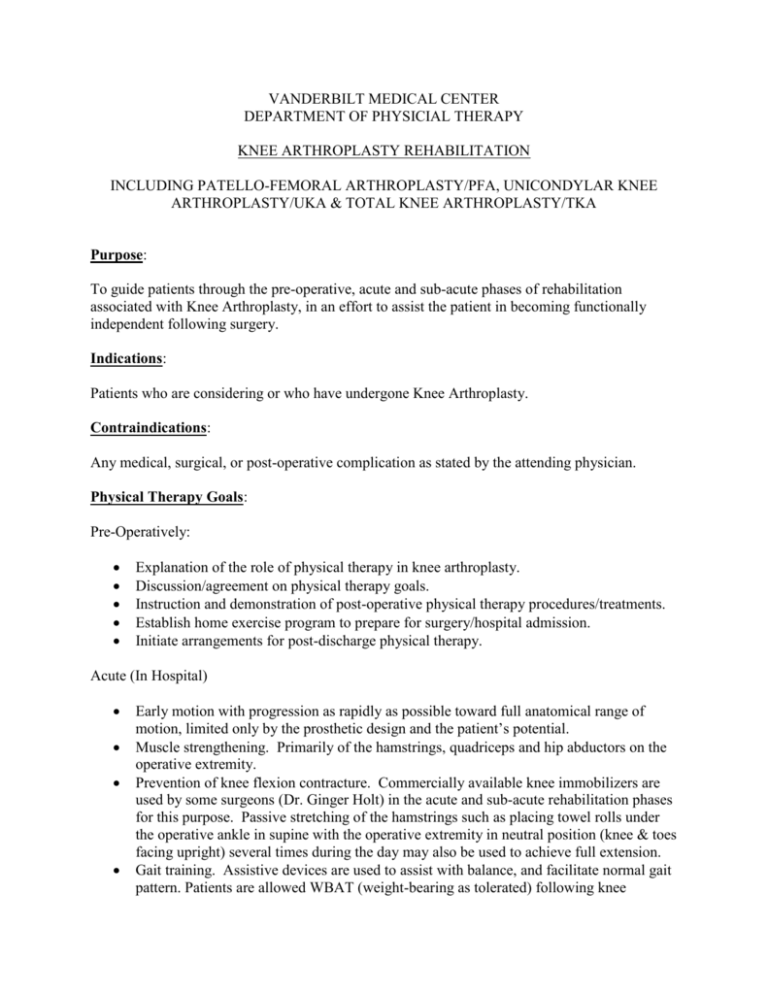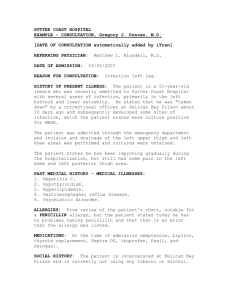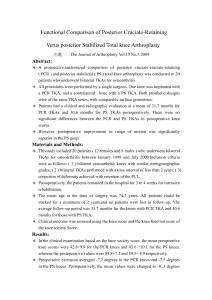knee arthroplasty rehabilitation - Vanderbilt University Medical Center
advertisement

VANDERBILT MEDICAL CENTER DEPARTMENT OF PHYSICIAL THERAPY KNEE ARTHROPLASTY REHABILITATION INCLUDING PATELLO-FEMORAL ARTHROPLASTY/PFA, UNICONDYLAR KNEE ARTHROPLASTY/UKA & TOTAL KNEE ARTHROPLASTY/TKA Purpose: To guide patients through the pre-operative, acute and sub-acute phases of rehabilitation associated with Knee Arthroplasty, in an effort to assist the patient in becoming functionally independent following surgery. Indications: Patients who are considering or who have undergone Knee Arthroplasty. Contraindications: Any medical, surgical, or post-operative complication as stated by the attending physician. Physical Therapy Goals: Pre-Operatively: Explanation of the role of physical therapy in knee arthroplasty. Discussion/agreement on physical therapy goals. Instruction and demonstration of post-operative physical therapy procedures/treatments. Establish home exercise program to prepare for surgery/hospital admission. Initiate arrangements for post-discharge physical therapy. Acute (In Hospital) Early motion with progression as rapidly as possible toward full anatomical range of motion, limited only by the prosthetic design and the patient’s potential. Muscle strengthening. Primarily of the hamstrings, quadriceps and hip abductors on the operative extremity. Prevention of knee flexion contracture. Commercially available knee immobilizers are used by some surgeons (Dr. Ginger Holt) in the acute and sub-acute rehabilitation phases for this purpose. Passive stretching of the hamstrings such as placing towel rolls under the operative ankle in supine with the operative extremity in neutral position (knee & toes facing upright) several times during the day may also be used to achieve full extension. Gait training. Assistive devices are used to assist with balance, and facilitate normal gait pattern. Patients are allowed WBAT (weight-bearing as tolerated) following knee arthroplasty and may be progressed from their assistive device to a straight cane (if needed) at the discretion of the physical therapist. Post-Discharge: Achieve maximal knee range of motion as allowed by the prosthetic design and limited only the patient’s potential. Average knee motion, which may be achieved, is approximately 130 flexion. Muscle strengthening of the entire lower quadrant of the operative extremity. Attention should also be directed toward any weakness present in the upper extremities, trunk, or contralateral lower extremity. Proprioceptive training to improve body/spatial awareness of the operative extremity in functional activities. Endurance training to increase cardiovascular fitness. Functional training to promote independence in Activities of Daily Living and mobility. Gait training. Assistive devices are discontinued when they are no longer needed, as deemed by the Physical Therapist. Attempts should be taken to achieve a safe, efficient gait pattern at that time. Physical Therapy Rehabilitation Guidelines Milestones for Patient Progression: Dr. Ginger Holt’s patients are required to sleep at night in their knee immobilizer for a passive hamstring stretch for 2 weeks following their knee arthroplasty. Discharge from the Acute Care setting with 90 knee flexion, approximately 2-3 days post-operative for standard TKA; discharge home post-op day 1 for UKA. Discontinue assistive devices for ambulation as soon as a safe gait pattern on all surfaces is achieved; this is at the discretion of the physical therapist. Discharge from Sub-Acute Physical Therapy program to independent home exercise program when knee flexion is ~ 120. Patient are allowed to resume driving 4 weeks after surgery Restrictions: Return to sports per AAOS guidelines. Avoid involvement in sporting activities requiring high-speed running and/or jumping unless approved by the attending surgeon, based upon the type of surgical implant (i.e. fixed-bearing versus mobile-bearing). Treatment Parameters: Pre-Operative Participation in education class on Knee Arthroplasty. Material covered in this class includes discussion of normal vs. abnormal knee joint anatomy, components of knee prosthesis, intra-operative sequence of events, identification of post-operative complications and preventative measures, admission procedures for Vanderbilt Medical Center, post-operative rehabilitation, and discharge needs. Pre-operative Physical Therapy assessment at the time of the knee class. This session includes a baseline assessment of joint range of motion, muscle strength, mobility and functional assessment using rehab specific functional tools. Acute Care (Vanderbilt Medical Center) BID physical therapy sessions with efforts to achieve discharge 2-3 days after surgery. Day of Surgery: Dr. Holt’s patients sleep in a knee immobilizer each night for 2 weeks (passive hamstring stretch) beginning the night of surgery. CPM no longer routinely used by any surgeons. Begin lower extremity isometric exercises and ankle pumps. Encourage the patient to perform these exercises every 30 minutes while awake. Initiate A, AAROM exercises to operative knee/LE as tolerated. Exercises may be performed in supine &/or sitting positions at therapist’s discretion. Begin mobility training if patient is medically stable per nursing staff and arrive on patient care unit. Initiate OOB activities using assistive device, WBAT on operative extremity. Post-operative pain control is via a multi-modal pain regimen including, but not limited to a single-shot Sciatic nerve block and intraarticular joint injections. Post-Operative Day 1- Discharge: Continue lower extremity isometrics and ankle pumps (every 30 minutes) and begin assisted straight leg raises (SLR), TKE/SAQ, etc. Initiate upper extremity and contralateral limb strengthening exercises as needed. Therapeutic exercises to operative LE. Passive, active, active-assisted range of motion exercises to the operative lower extremity (supine &/or sitting) with the emphasis on knee flexion and extension. No restrictions to motion and range is to the patient’s tolerance unless specifically restricted by the attending surgeon. Soft tissue massage/mobilization, joint mobilization (unless hinged implant), end-range strengthening exercises, muscle energy, contract/relax exercises are all appropriate and performed at the therapist’s discretion. Ice packs or the cooling machine should be applied to the operative knee at the conclusion of the therapy exercise session. Begin assisted ambulation on level surfaces and stairs using an assistive device, WBAT on the operative extremity. Discharge planning and home needs assessment. Review/distribute home exercise program Post-Discharge Care Patients who have acutely undergone Knee Arthroplasty are strongly encouraged to receive follow-up physical therapy in an outpatient clinic setting. However, due to transportation limitations, support services, and/or functional limitations, this may not be a feasible option. If this is the case, the multidisciplinary team will, prior to discharge from the acute care setting, make arrangements for the patient to receive physical therapy services at home, Extended Care Facility (ECF) or Inpatient Rehabilitation Center. Criteria for each setting are listed below: Home Health Physical Therapy – Patients with transportation difficulties, functional limitations restricting mobility (difficulty with transfers, etc.). Home physical therapy services are to be discontinued as early as possible and utilized no longer than 2 weeks post-surgery with services transferred to an outpatient setting unless approved by surgeon. Out-Patient Physical Therapy – Patients with transportation available to an outpatient department are strongly encouraged to begin their post-discharge therapy in this setting. Extended Care Facility Physical Therapy – Patients who live alone or have limited support services to assist with home care activities (i.e. no family members or friends able to help with homemaker activities and transportation to/from therapy) and whose overall endurance level is diminished and would interfere with their participation in a comprehensive rehabilitation program. Inpatient Rehabilitation Center – Patients who pre-operatively lived alone and were independently functioning in that environment and will be returning to that living arrangement at the conclusion of their rehabilitation; also, their general medical status and cardiovascular endurance is sufficient to participate in an intensive rehabilitation program. Most importantly, insurance coverage/funding dictate treatment in this setting. Fitness/Wellness Centers – Younger and physically active patients who have achieved functional range of motion and muscle strength in their operative knee maybe referred to fitness centers for instruction and/or supervision in general conditioning programs; this may be one of the later phases of rehabilitation following TKA, involving a limited number of patients. Within each of the settings, a comprehensive treatment program should be implemented based upon each individual patient’s needs and within established therapy restrictions. Suggested physical therapy treatment/activities are listed below: Modalities for Pain Control, Edema Reduction: Moist Heat FES TENS Ice Interferential Kinesio-taping Lymphedema Techniques Galvanic Stimulation Negative Electrical Stimulation Therapeutic Exercise: Passive, active-assisted, active lower extremity range of motion Contract/Relax exercises Isokinetics for passive knee range of motion Joint mobilization to the knee (unless hinged knee prosthesis) Soft tissue mobilization of the hamstrings and quadriceps Closed kinetic chain activities Tibial rotational exercises Stationary biking – no resistance to motion PNF (lower extremity patterns) with/without resistance Lower extremity strengthening exercises using theraband &/or ankle weights; patients may progress to resistive exercises on the operative extremity as able Nordic Track Stair-Step Machine Aquatic Therapy/Activities Scar Massage/Mobilization – maybe initiated after suture removal and when the incision is clean and dry Gait Training: Level Surfaces Forward Walking Sidestepping Backward or Retro-Walking Uneven Surfaces Stair Climbing Activities Functional Training: Standing Activities Transfer Activities Lifting Carrying Pushing or Pulling Squatting or Crouching Return-to-Work Tasks Sporting Activities – return to sports based upon AAOS guidelines and surgeon discretion Balance /Proprioception Training: Tandem Walking Lateral Stepping over/around objects Obstacle Course Lower Extremity PNF Patterns Weight-Shifting Activities Closed Kinetic Chain Activities REFERENCES: National Institute of Health Consensus Statement on Total Knee Replacement. JBJS Am 86-A (6):1328-1335; June 2004 Cook JR, Warren M, Ganley KJ, Prefontaine P, Wylie JW. “A Comprehensive Joint Replacement Program for Total Knee Arthroplasty: A Descriptive Study.” BMC Musculoskeletal Dis 9:154; 2008 Walker FL, Bass N, Bock G, Markel DC. “Success of Clinical Pathways for Total Joint Arthroplasty in a Community Hospital.” Cl Orthop & Rel Res 457:133-137; April 2007 Peters CL, Shirley B, Erickson J. “The Effect of a New Multimodal Perioperative Anesthetic Regimen on Postoperative Pain, Side Effects, Rehabilitation and Length of Stay after Total Joint Arthroplasty.” J Arthroplasty 21(6), Suppl 1:132-138; September 2006 Jordan LR, Siegel JL, Olivo JA. “Early Flexion Routine. An Alternative Method of Continuous Passive Motion.” Cl Orthop & Rel Res 315:231-233; 1995 Nuelle DG, Mann K. “Minimal Incision Protocols for Anesthesia, Pain Management and Physical Therapy with Standard Incisions in Hip and Knee Arthroplasties. The Effect of Early Outcomes.” J Arthroplasty 22(1):20-25; January 2007 Parvizi J, Azzam K, Rothman RH. “DVT Prophylaxis for Total Joint Arthroplasty: AAOS Guidelines.” J Arthroplasty 23(7) Supp 1: 2-5; October 2008 Updated 7/14 SS PT, GTC





